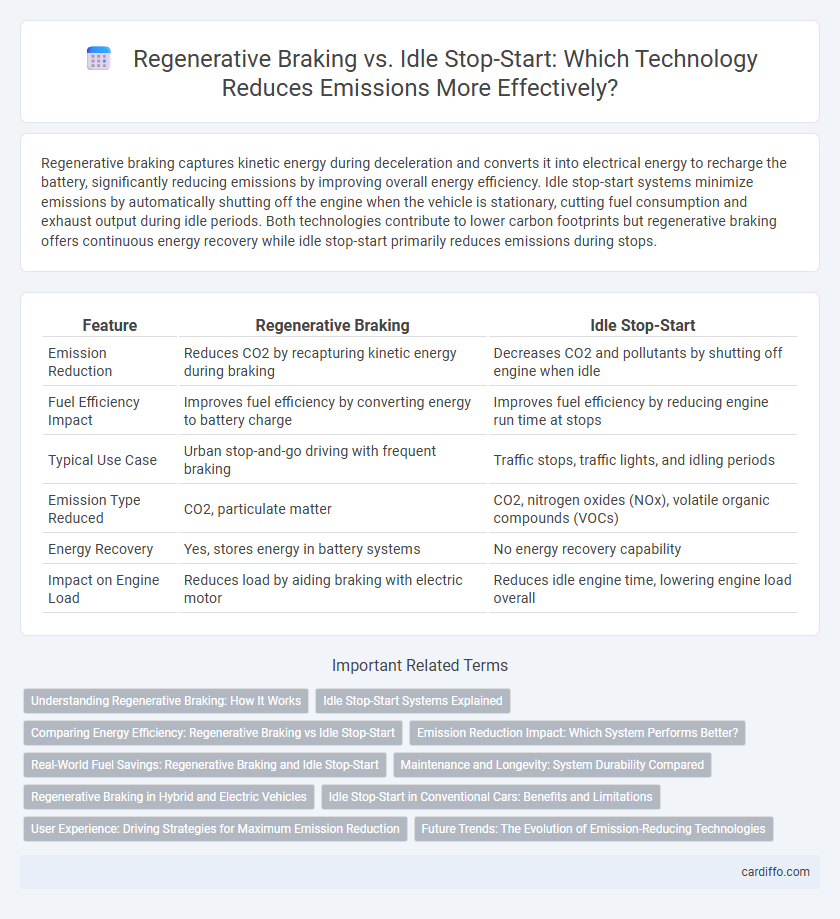Regenerative braking captures kinetic energy during deceleration and converts it into electrical energy to recharge the battery, significantly reducing emissions by improving overall energy efficiency. Idle stop-start systems minimize emissions by automatically shutting off the engine when the vehicle is stationary, cutting fuel consumption and exhaust output during idle periods. Both technologies contribute to lower carbon footprints but regenerative braking offers continuous energy recovery while idle stop-start primarily reduces emissions during stops.
Table of Comparison
| Feature | Regenerative Braking | Idle Stop-Start |
|---|---|---|
| Emission Reduction | Reduces CO2 by recapturing kinetic energy during braking | Decreases CO2 and pollutants by shutting off engine when idle |
| Fuel Efficiency Impact | Improves fuel efficiency by converting energy to battery charge | Improves fuel efficiency by reducing engine run time at stops |
| Typical Use Case | Urban stop-and-go driving with frequent braking | Traffic stops, traffic lights, and idling periods |
| Emission Type Reduced | CO2, particulate matter | CO2, nitrogen oxides (NOx), volatile organic compounds (VOCs) |
| Energy Recovery | Yes, stores energy in battery systems | No energy recovery capability |
| Impact on Engine Load | Reduces load by aiding braking with electric motor | Reduces idle engine time, lowering engine load overall |
Understanding Regenerative Braking: How It Works
Regenerative braking captures kinetic energy from a vehicle's wheels during deceleration, converting it into electrical energy stored in the battery for later use. This process reduces reliance on the engine, lowering fuel consumption and emissions compared to traditional braking. Unlike idle stop-start systems that shut off the engine at stops, regenerative braking actively recovers energy lost during driving, contributing significantly to improved overall vehicle efficiency.
Idle Stop-Start Systems Explained
Idle stop-start systems reduce vehicle emissions by automatically shutting off the engine during idle periods, such as at traffic lights, and restarting it when the driver engages the clutch or releases the brake. This technology lowers fuel consumption and decreases CO2 emissions by minimizing unnecessary engine operation. Compared to regenerative braking, idle stop-start specifically targets stationary engine idling, making it highly effective in urban driving conditions with frequent stops.
Comparing Energy Efficiency: Regenerative Braking vs Idle Stop-Start
Regenerative braking recovers kinetic energy during deceleration, converting it into electrical energy stored in the battery, thereby reducing overall fuel consumption and emissions. Idle stop-start systems save fuel by shutting off the engine when the vehicle is stationary, but they do not recover energy as regenerative braking does. Studies show regenerative braking improves energy efficiency by up to 20% more compared to idle stop-start, especially in urban driving conditions with frequent stops.
Emission Reduction Impact: Which System Performs Better?
Regenerative braking captures kinetic energy during deceleration and converts it into electrical energy, significantly reducing CO2 emissions by enhancing overall vehicle efficiency. Idle stop-start systems reduce emissions by shutting off the engine during idle periods, cutting fuel consumption but offering limited impact in dynamic driving conditions. Studies show regenerative braking achieves greater emission reduction benefits, especially in urban stop-and-go traffic, by recovering energy that idle stop-start cannot harness.
Real-World Fuel Savings: Regenerative Braking and Idle Stop-Start
Regenerative braking recovers kinetic energy during deceleration, converting it into electrical energy to recharge the battery, which significantly reduces fuel consumption in urban stop-and-go traffic. Idle stop-start technology automatically shuts off the engine during stationary periods, cutting fuel use and emissions by preventing unnecessary idling. Combining both systems can enhance overall fuel efficiency, with regenerative braking maximizing energy recapture and idle stop-start minimizing engine running time.
Maintenance and Longevity: System Durability Compared
Regenerative braking systems generally require less maintenance compared to idle stop-start systems due to fewer mechanical components subject to wear, enhancing overall system durability. The frequent engine restarts in idle stop-start technology can accelerate wear on starters and batteries, potentially leading to higher maintenance costs over time. Vehicle models equipped with regenerative braking frequently report longer component lifespans and reduced service intervals, contributing to improved longevity and lower emission-related expenses.
Regenerative Braking in Hybrid and Electric Vehicles
Regenerative braking in hybrid and electric vehicles significantly reduces emissions by converting kinetic energy into electrical energy during deceleration, which is stored in the battery for later use. This process enhances energy efficiency and lowers fuel consumption compared to traditional braking systems that dissipate energy as heat. By capturing and reusing braking energy, regenerative braking directly contributes to decreased greenhouse gas emissions and improved overall environmental performance of these vehicles.
Idle Stop-Start in Conventional Cars: Benefits and Limitations
Idle Stop-Start systems in conventional cars significantly reduce emissions by shutting off the engine during idle periods, lowering fuel consumption and CO2 output. These systems help decrease urban pollution and improve fuel efficiency, especially in stop-and-go traffic conditions. However, frequent engine restarts can strain components like the starter motor and battery, and the system's effectiveness depends on driving patterns and ambient temperature.
User Experience: Driving Strategies for Maximum Emission Reduction
Regenerative braking captures kinetic energy during deceleration, converting it into electrical energy to recharge the battery and reduce emissions by lowering fuel consumption. Idle stop-start technology automatically shuts off the engine during prolonged stops, minimizing fuel waste and tailpipe emissions in urban traffic conditions. Combining both systems encourages smoother driving habits, optimizing energy recovery and reducing overall vehicle emissions effectively.
Future Trends: The Evolution of Emission-Reducing Technologies
Regenerative braking systems capture kinetic energy during deceleration and convert it into electrical power, significantly reducing fuel consumption and CO2 emissions in hybrid and electric vehicles. Idle stop-start technology minimizes emissions by automatically shutting off the engine during idling, cutting unnecessary fuel use in urban driving conditions. Future trends indicate integration of AI-driven energy management systems to optimize these technologies, alongside advancements in battery efficiency, further lowering vehicular carbon footprints and supporting stricter global emission regulations.
Regenerative Braking vs Idle Stop-Start Infographic

 cardiffo.com
cardiffo.com